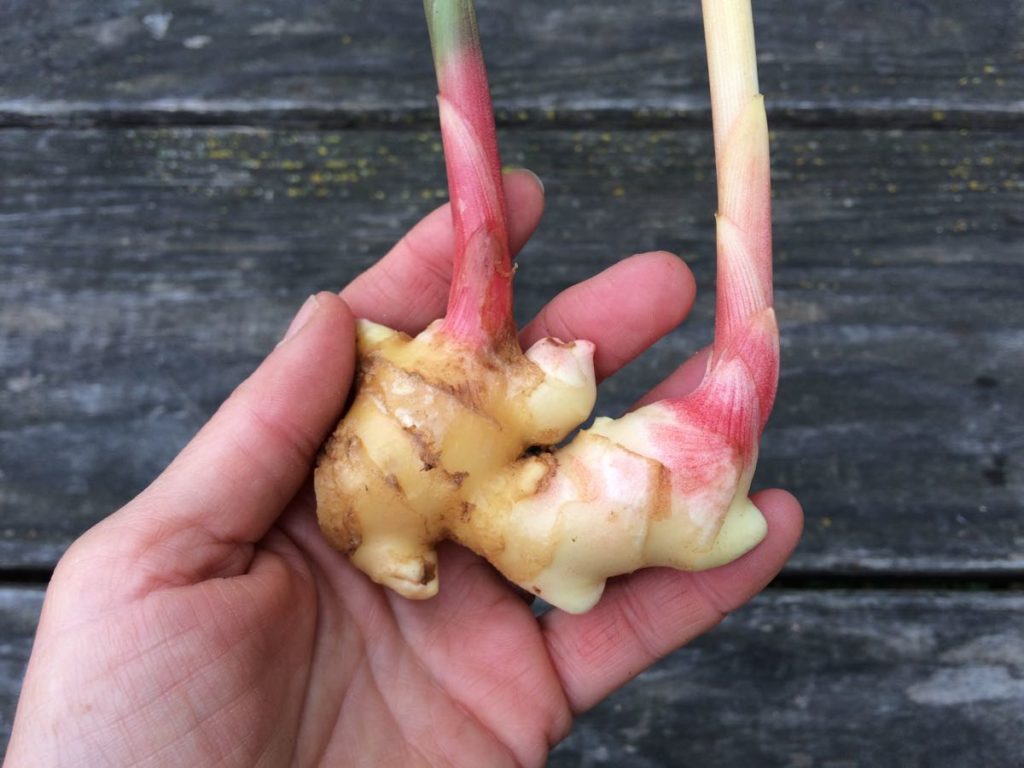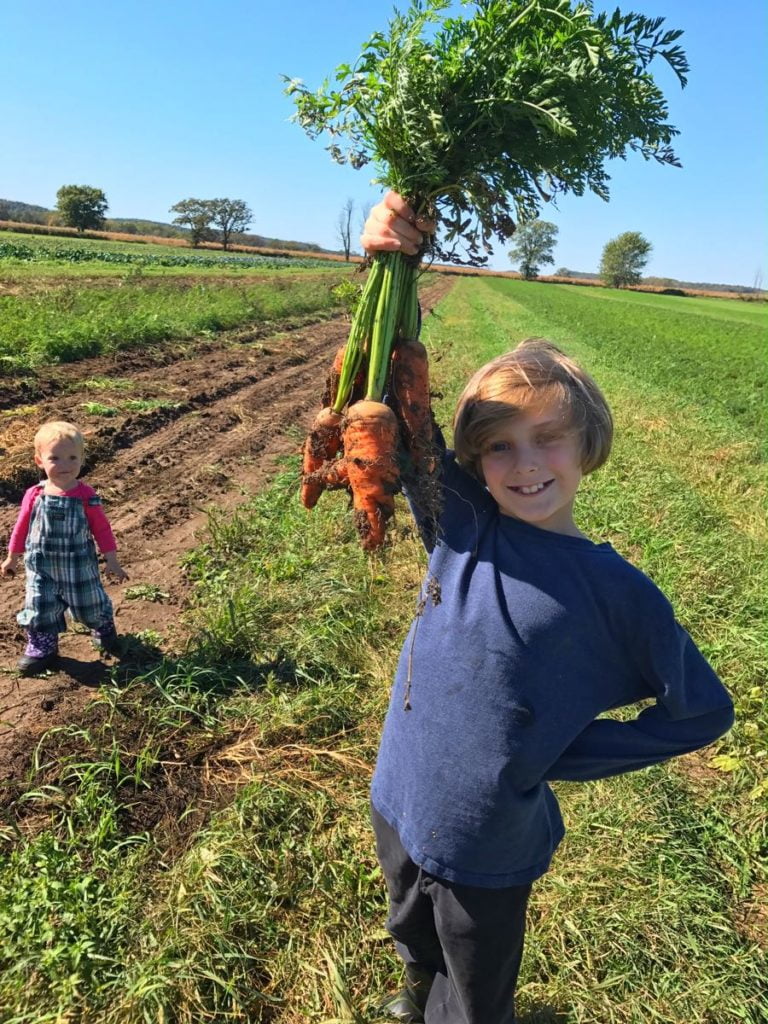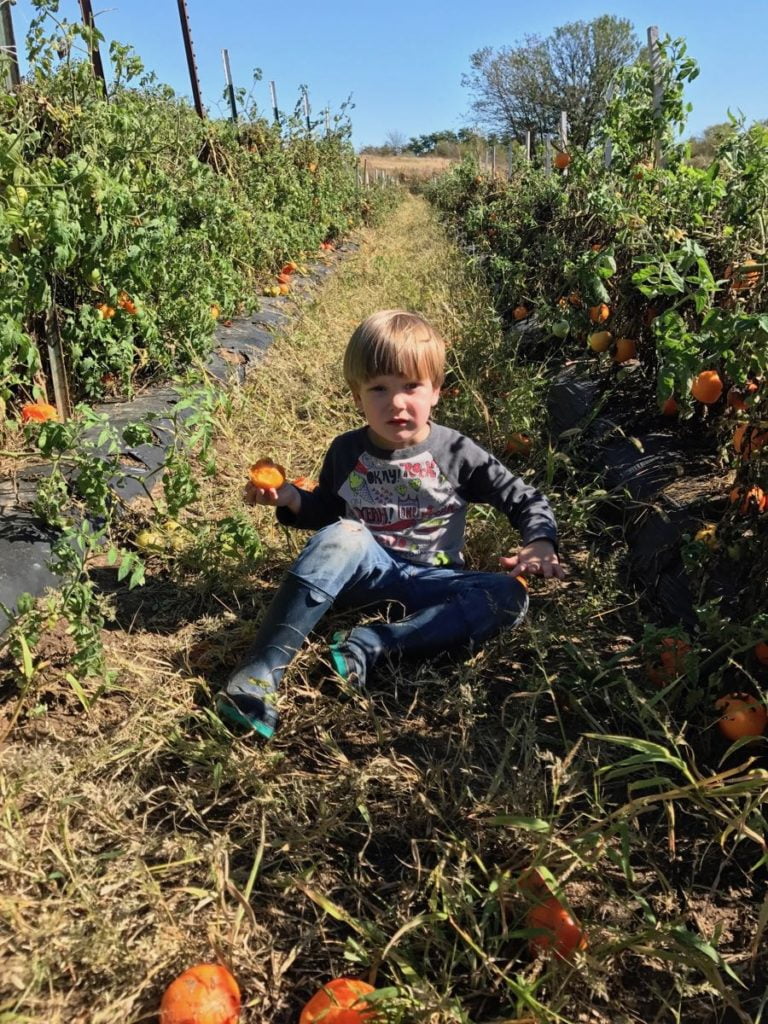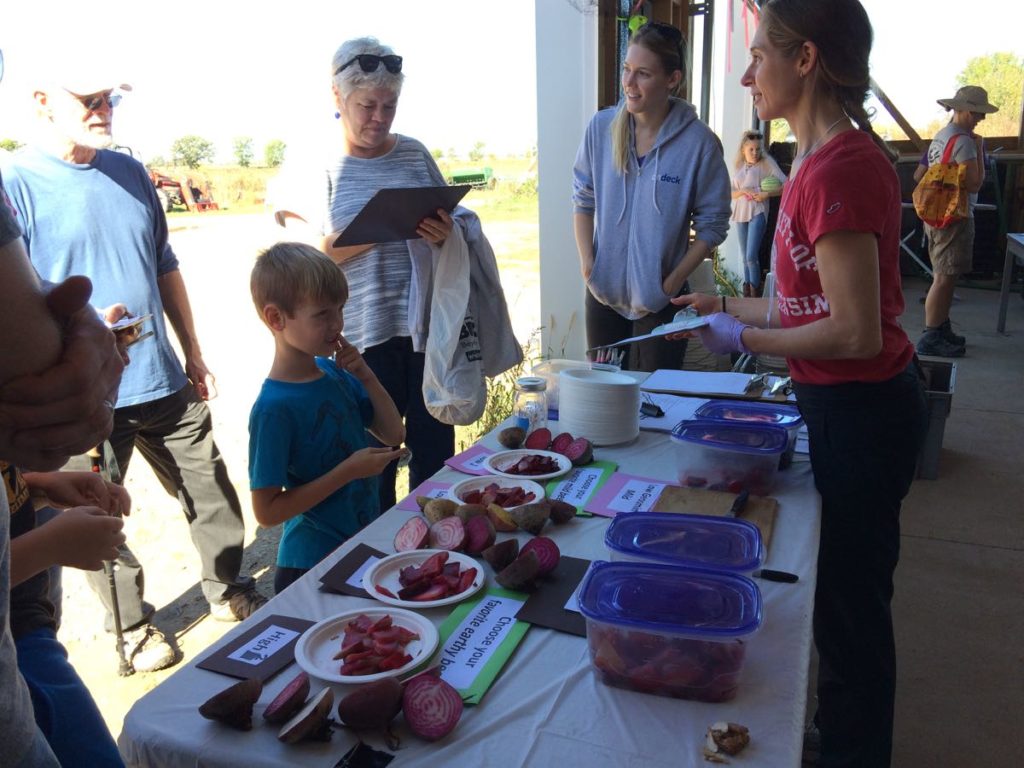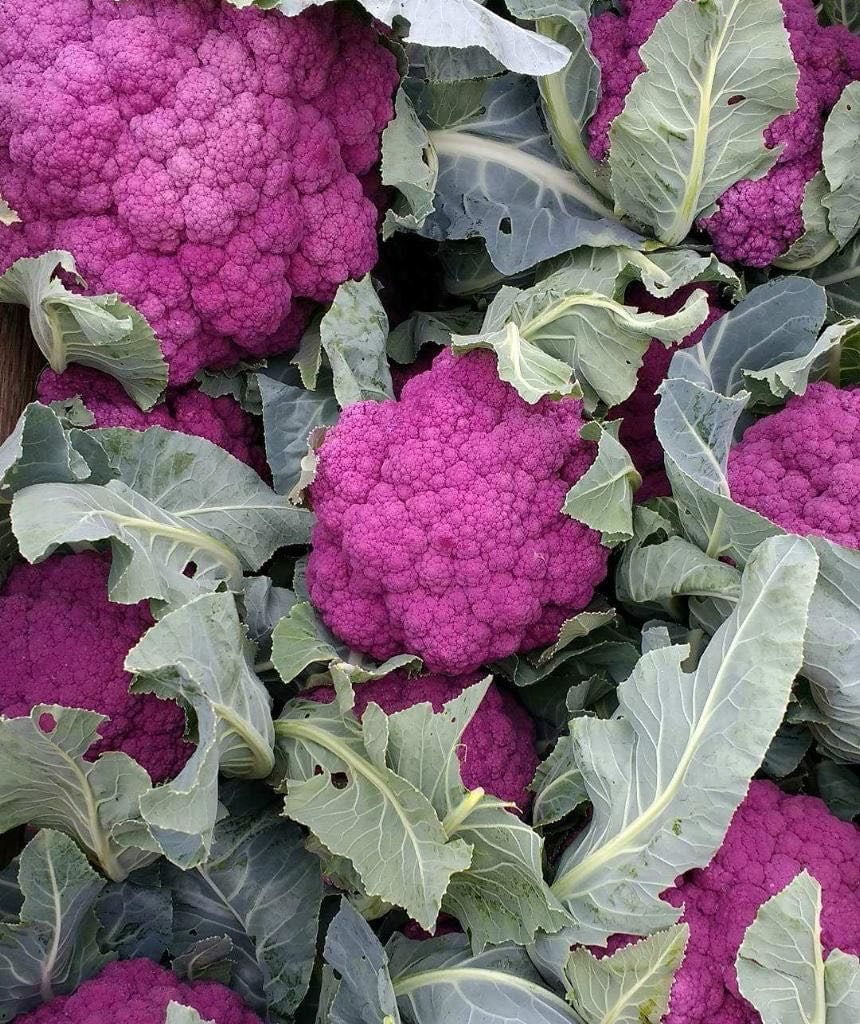Monthly Archives: October 2017
Good bye!; Oct 26 2017
- On: October 25, 2017
 0
0
This is the last delivery for our May-October CSA shares. Thank you, thank you, thank you for being members of our farm. We truly appreciate your commitment to our CSA. We could not farm without you. We hope you enjoyed the adventure.
Many of you registered for continued deliveries with our Extension and Storage shares. We will be in touch with more information as those deliveries approach.
We will open registration for our 2018 season by early December. Watch for emails from us. In the meantime, you can continue eating our produce through the winter. Our stored cabbage, carrots and other roots will be on the shelves at these stores: Willy Street Coop (Madison, Middleton), Outpost Natural Foods (Mequon and Milwaukee area), Basics Coop (Janesville), Whole Foods (Madison only, with deliveries beginning soon), Good Harvest Market (Pewaukee), and Health Hut (Brookfield).
Love,
Beth and Steve
Best year ever (maybe). Highs and lows
This is a good moment to evaluate the season. I think the title above says it all. 2017 was a terrific season for us. With a few exceptions, the crops were abundant. Even the weather wasn’t too bad. The ‘maybe’ in the title simply indicates that our work is not finished yet. Our big storage harvests stretch over the next few weeks. We have a lot of good-looking crops in the field and hope to have our coolers stuffed full by Thanksgiving. Keep your fingers crossed for dry weather.
We sat down with the crew to brainstorm the highs and lows of this season.
HIGH – Best crew ever. Most of our 22 farmhands and managers were returning employees, and our three new hires brought a combined 50+ years experience in growing vegetables. Wow. Together, this crew has deep, deep knowledge of vegetables. Having so much experience on the farm took the pressure off Steve and me, allowing us to relax a bit and enjoy our work in a new way.
HIGH – Steve was healthy, pain-free and energetic this year. He spent the 2016 season in pain from a bicycle mishap, and limited in the energy he could muster for farming. He began working with a new physical therapist this past winter with amazing results. She showed him new techniques like “nerve flossing” that sped his recovery. He feels like a new man.
HIGH – I love our new experimental prairie planting. It was a fascinating new hobby and I did not even realize how much I need a hobby. Nevermind that it involves plants and field prep and transplanting, it still counts as a hobby.
HIGH – As mentioned above, most of our crops grew very well this year. The moderate weather helped. Even during the mid-summer rainy spell, most of the rain came at night, making work easier and more pleasant for all of us. A dry start to the summer plus dry fall weather kept crop diseases in check. Usually a whole bunch of different crop diseases explode in fall. Not this year. As a result, our fall brassica crops have been amazing! We’ve never had this much broccoli and cauliflower to share in the CSA boxes.
LOW – Unfortunately, a troubling new disease appeared during that mid-summer rainy spell. For years I’ve told Steve “If we can get through our farming careers without Phytophthora capsici (Pcap) showing up, I’ll be happy.” Well, Pcap showed up this year, wiping out entire melon fields and eliminating all the late melons we planted for you. That was painful. I have photographs of those fields but I am not going to share them with you. This is a family-friendly newsletter and the photos are like a snuff film.
LOW – Pcap also damaged about a third of our peppers. Our pepper crew wore uncomfortable plastic booties over their shoes for months to confine Pcap to the infected fields. That was a low for all involved.
HIGH/LOW – Daily use of the word “bootie” inspired one crew member to endless baudy jokes.
HIGH – There was a shining moment when six of our farm pickup trucks were working. That’s extraordinary. Of course, it only lasted one day before one of them broke. We use a combination of tractors and wagons plus pickup trucks for our harvests, giving each field team something for transport. The number of operating pickups directly affects our collective quality of life. Life is good when the pickups are running.
LOW – There was a dispiriting day when only one pickup was operating.
LOW – One day, a door suddenly fell off one of the pickups! The crew managed to realign it and lock it in place. We haven’t opened that door again. Fixing it is a winter project.
HIGH – The 2nd staked tomato field and the 3rd kale plantings were genuine high points. Those two fields just kept on giving.
HIGH – A garter snake took up permanent residence in one of the zucchini fields, appearing reliably during each zucchini harvest.
LOW – The garter snake always showed up in the row worked by the crew member who is terrified of snakes.
HIGH/LOW – One time, the crew found a garter snake with a toad in its mouth. The toad was still alive, feebly gasping and waving its arms. That’s the stuff of legends or nightmares or at least persistent farm memories.
HIGH – Poblano chiles. Wow, they were abundant this year. That’s why we could pack them in the boxes two times.
HIGH – Best farm lunches ever! A woman in Madison cooks lunch for our crew two days per week. She has cooked for us for years but was on a roll this year, with creative, abundant dishes. Thank you Gen!
HIGH – Finger weeders! Steve set up finger weeders, a new type of cultivating tool that does an amazing job. We weeded quite a few fields just by tractor, with no follow-up hand weeding, saving so much effort.
HIGH – Due to the finger weeders, we had beautiful, weed-free cabbage fields situated near the buildings where we could look at them every day. Ah, so nice.
LOW – Lake Tipi. Somehow, we ended up with an enormous, truck-devouring pothole. We have got to fix that.
That’s all I’m going to share. The crew had many more ideas but their highs and lows were getting pretty obscure (“Remember the time Billy caught a corndog in his mouth when you threw it from the porch?”, etc., etc.) You don’t need to hear these things! Thank you again for being Tipi-people this year. Beth.
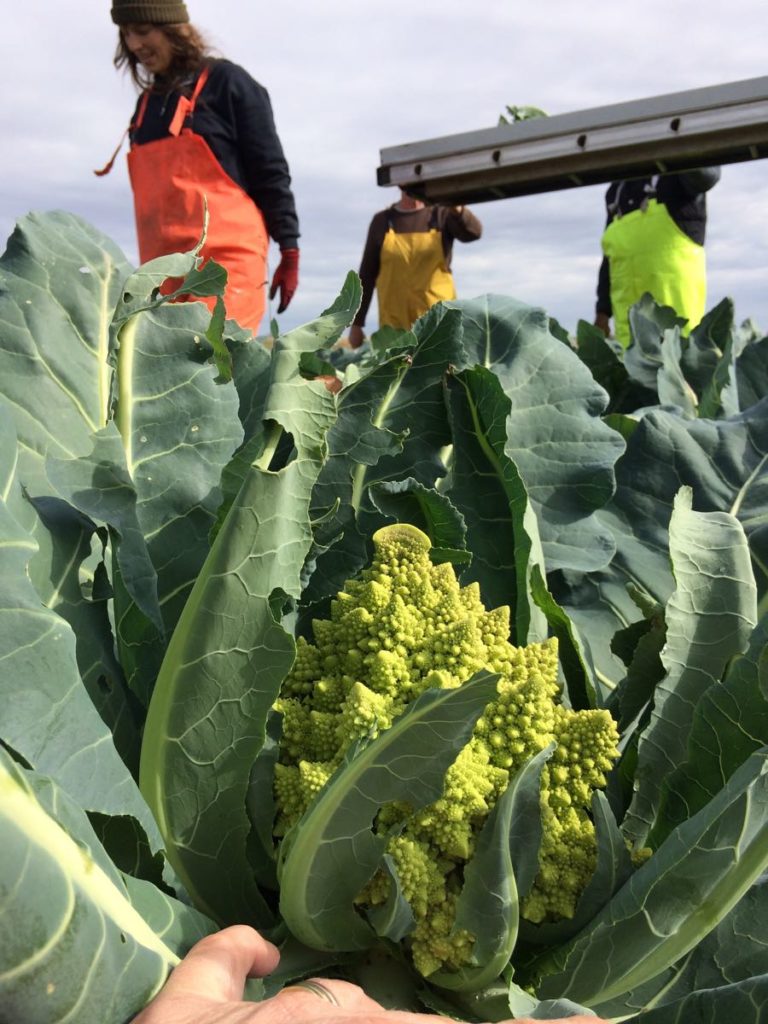
Fractally beautiful Romanesco at harvest. That’s Charlotte in the background.
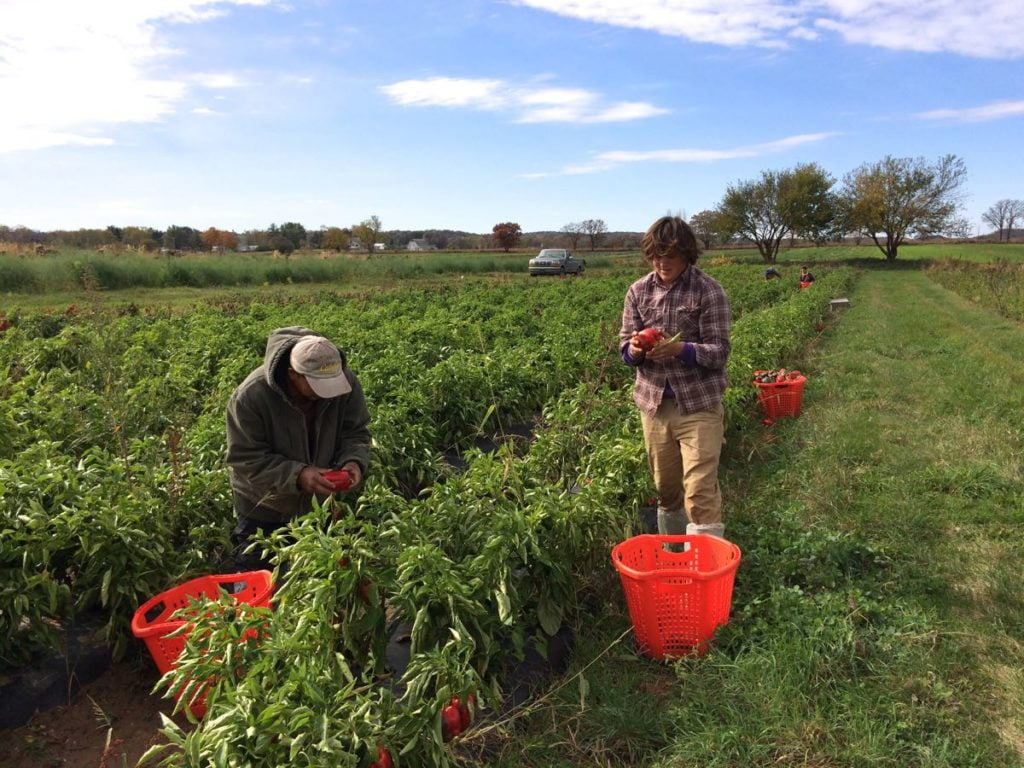
It’s likely to frost tonight, so we stripped the pepper field of the last peppers. Above, Raul and Jory bring in the harvest. Look at Jory’s feet – you can just see his boot covers behind the basket. The valiant pepper crew wore boot covers for months to avoid spreading a new disease beyond the infected fields. A big thanks to Simone, Jim, Raul and Jory for making the effort. We know it was uncomfortable.
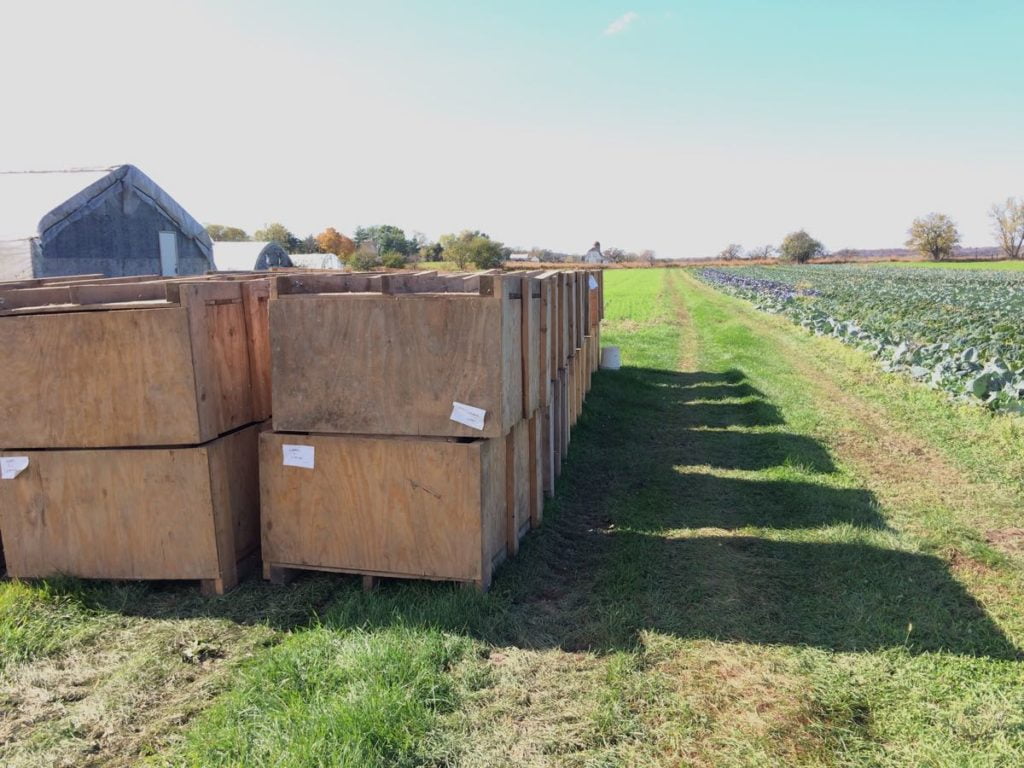
We’re preparing for our big, big carrot harvests. The wooden bins are repaired and ready to go. Steve’s worked over the carrot harvester. We have someone coming tomorrow to do preventative maintenance on our storage coolers. Carrot and root harvests start this week and extend into mid-November. We can’t afford any downtime during these critical weeks. Wish us luck! We should have enough cabbage, carrots and other roots to supply our store customers through the winter.

The cover crops are so vibrant right now. They protect against erosion during the winter, then revive and grow again in spring to nourish the soil. If you review the four photos above, the color green pops out. The farm glows on sunny days. It’s not too shabby on cloudy days either.
VEGGIE LIST and VEGGIE NOTES
(Oct. 26/27, 2017; week #24, purple EOW)
Sweet potatoes, 2 – 2.5 lb
Butternut squash
Red cabbage
Brussels sprouts, 1 lb
Romanesco
Celeriac
Purple daikon radish
Green bell peppers, ~2
Yellow onion
Shallots, 1 – 3
Baby ginger, 1 knob
This is the final box of our regular CSA season.
Romanesco (pale green conical head, possible tinged with purple) – This is the prettiest vegetable we grow. Look at it closely to appreciate its branched beauty and repeating spiral pattern. It is closely related to cauliflower which it resembles in flavor and texture.
Preparation: Like broccoli and cauliflower, it is fine eaten raw or cooked. It requires cooking times intermediate between the two. Don’t overcook it. I usually steam it, then dress it simply with a butter-lemon-garlic-mustard sauce.
Celeriac (knobby, round, bizarre-looking vegetable which smells like celery) – Flavorful celeriac is good raw or cooked. It is excellent in mixed roasted veggies or in soup. It’s especially good in cream soups, alone or mixed with potatoes. Grated raw celeriac is a great starting point for winter salads. Celeriac will store in your refrigerator for months. Cut off chunks as you need them. Peel before using.
Shallots – These look like small red onions. They can be round or oblong. Store at room temperature. This is the first time we’ve grown these! They seemed like a fun thing to try and have turned out nicely. Honestly, I am a novice with shallots but from what I’ve read (and eaten at restaurants) they are good in salad dressing, and caramelized and used to top dishes or sandwiches. Have fun!
Baby ginger – This is baby ginger, bright white and pink because it hasn’t grown a brown epidermis yet. The ginger in stores is grown for a long season in warm places like Hawaii. Baby ginger is special because it has the full ginger flavor and spiciness but almost no fibers. That’s why it’s used to make the pickled ginger served with sushi. I asked the crew to wash it lightly to avoid bruising. Expect to do a final wash before using it.
Storage: Eat soon; baby ginger is perishable. Wrap in a damp cloth or paper towel, and keep in the refrigerator in a plastic bag. You can also freeze your ginger, then grate as much as you need from the frozen knob.
RECIPE LOG
Visit our Recipe Log, a list of all our 2017 recipes.
LOCAL THYME RECIPES
Comforting Classics
Romanesco Gratin
Chicken or Tofu and Brussels Sprout Stir Fry with Ginger
Rice Bowl with Romanesco, Bell Pepper, Cabbage and Fried Egg
Celeriac Ribbon Remoulade
Outside the Box Recipes
Romanesco Polonaise
Brussels Sprouts Braised in Nutmeg Cream
Red Cabbage and Apple Soup
Celeriac, Smoked Mozzarella and Prosciutto Salad
Quick and Easy Meal
Roasted Sweet Potatoes and Brussels Sprouts with Miso Vinaigrette
RECIPES FROM LAUREN
DEEP DISH HARVEST PIZZA
If there is anything I love more than taking every vegetable I have and throwing it into one mess of a beautiful deep-dish pizza, I don’t know what it would be. This recipe is simple, insanely versatile and (as usual) fit for a crowd. It only makes one pizza so you won’t think it’s a lot of food, but trust me, this baby is dense. If you aren’t vegetarian, I totally recommend throwing some bacon on there. Enjoy! Lauren.
Serves 6-8
Takes 1 hour, 15 minutes
4 cups peeled and chopped butternut squash
2 cups water
2 teaspoons Kosher salt, divided
2 tablespoons olive oil plus more for drizzling
2 cups halved and quartered brussels sprouts
1 head romenesco, cut into bite-size florets
1 green pepper, diced (about 1/2 cup)
1/4 teaspoon freshly ground black pepper
1 tablespoon butter
2 shallots, peeled and thinly sliced
1 tablespoon maple syrup
1/2 teaspoon red pepper flakes
2 cups favorite pizza cheese (I used a blend of havarti, munster and Parmesan but mozzarella is also great on its own)
- Preheat the oven to 450 degrees.
- If making pizza dough from scratch, begin the dough now (see below). If not, skip to the next step.
- In a medium sauce pan, combine winter squash, water and 1/2 teaspoon Kosher salt. Bring to a boil, reduce to a simmer and cook for 25 minutes until squash is very soft. Drain and return to pan.
- Drizzle two tablespoons olive oil on a baking sheet. Add brussels sprouts, romanesco, green pepper, pepper and 1 teaspoon Kosher salt. Roast for 25 minutes, turning once for even cooking.
- While the winter squash simmers and veggies roast, melt a tablespoon of butter in a large cast-iron skillet. Add shallots along with remaining 1/2 teaspoon Kosher salt. Cook for 5-10 minutes until beginning to char in places. Add to drained winter squash along with maple syrup and red pepper flakes. Mash with a potato masher (or fork) until mostly smooth.
- Remove veggies from oven and bump temperature up 500 degrees.
- Drizzle cast-iron skillet with a bit of oil and then press pizza dough into pan and up the sides. It will stretch and sink but just keep pushing it up the sides until it stays about 2/3 of the way up. Let rest for a couple minutes while you shred the cheese.
- Add half the cheese to your pizza crust. Top with mashed winter squash and spread into an even layer. Add roasted veggies followed by remaining cheese.
- Bake for 25 minutes until crust is golden and cheese is bubbling. Serve warm.
.
Pizza dough:
1 cup warm (but not hot) water
1 packet instant yeast (or 2-1/2 teaspoons)
Pinch sugar
1 teaspoon Kosher salt
4 tablespoons olive oil
3 cups all-purpose flour
- Combine water, yeast and sugar together in a small bowl or measuring cup. Let sit for 5 minutes so the yeast proofs and becomes all yeasty.
- Add salt and olive oil to the yeast mixture.
- Pour flour into a large bowl (preferably your mixing bowl if you have one). Slowly stir in yeast liquid and stir until clumpy dough forms.
- Turn out dough onto counter and knead until smooth, and shape into a ball.
- Grease bowl you used to make dough and place dough ball in it. Cover with plastic and set in a warm place (like the warm oven that’s roasting your veggies) until ready to use. For me, this was 40 minutes and it was perfectly doubled in size.
.
.
SWEET POTATO CABBAGE BOWL WITH CASHEW LIME DRESSING
Takes 45 minutes
Serves 4-6
2 pounds sweet potatoes, cut into bite-size pieces
1 yellow onion, cut in chunks
2 tablespoons olive oil
2 teaspoons Kosher salt, divided
1/4 teaspoon freshly ground black pepper
1/2 cup quinoa
1/2 cup lentils
1-1/2 cup water
1/2 red cabbage, shredded
1 purple daikon, quartered and very thinly sliced
2 avocados, sliced
Sesame seeds, optional
Cashew Lime Dressing:
1/3 cup cashew (or almond or peanut) butter
1/3 cup olive oil
1/3 cup lime juice (about 3 limes)
2 tablespoons maple syrup
2 tablespoons water
1 tablespoon soy sauce (or tamari)
1 tablespoon minced ginger
1 teaspoon Kosher salt
1/2 teaspoon cayenne pepper
- Preheat oven to 450 degrees.
- Drizzle baking sheet with olive oil and add sweet potatoes, onion, black pepper and 1 teaspoon Kosher salt. Roast for 25 minutes, turning once for even cooking.
- Rinse quinoa and add to a medium saucepan along with lentils and remaining 1 teaspoon Kosher salt. Toast over medium heat about 5 minutes, until little to no moisture remains. Add water and bring to a boil. Reduce to a simmer, cover and cook for 20 minutes. Turn off heat, but leave lid on and continue steaming for 5 minutes.
- Prepare dressing by combining all ingredients in a small bowl and whisk until smooth. Taste and adjust seasonings as desired. Add water if it’s too thick.
- Build bowls by placing about 1/2 cup of quinoa and lentil mixture in each bowl. Top with a quarter of the sweet potatoes and onions, a generous amount of cabbage and daikon, and half an avocado. Drizzle with sauce and sprinkle sesame seeds on top (if using).
.
Week #23, final purple EOW box
- On: October 19, 2017
 0
0
Box Countdown
October 19/20 (this week) = final box for purple EOW members
October 26/27 (next week) = final box for weekly members & for green EOW
Extension & Storage Shares in November – Just for members registered for these extra shares.
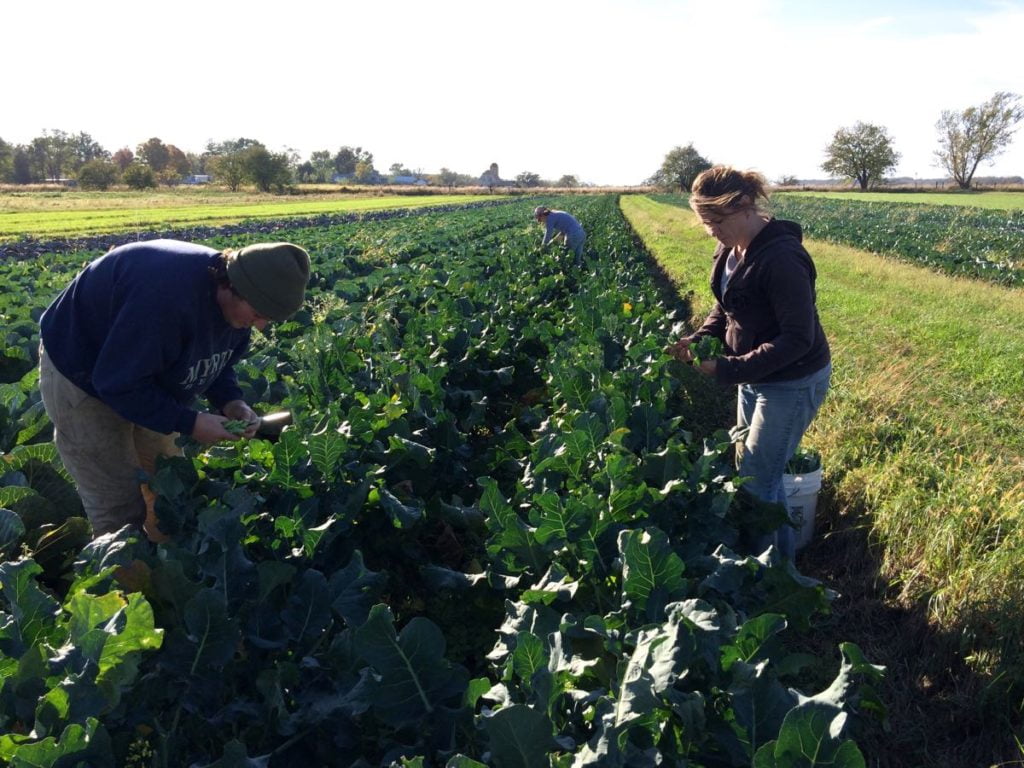
Jory, Kerry, and Karen in the broccoli field. The warm weather is OK for vegetables and wonderful for people.
Veggie List and Veggie Notes
(Oct. 19/20, 2017, week #23, purple EOW)
Beth’s box logic:
– Cauliflower. This has been an incredible year for broccoli and cauliflower. Some seasons, cauliflower is so rare that we only have enough for one CSA delivery. Not this year. We realize we have delivered cauliflower in your boxes at least three of the last four weeks. Let’s enjoy this bounty while it’s here. If you are feeling overwhelmed, you can freeze your cauliflower to use in winter soups. Here are Pat from Local Thyme’s instructions to freeze cauliflower: To freeze, wash and separate cauliflower florets, blanch for 3 minutes and submerge in ice bath. Drain well. Flash freeze by spreading the cauliflower out on a baking pan and putting them in the freezer to harden up. Once hard, pack the cauliflower in a plastic freezer bag and return to the freezer to store.
– Garnishes. We’ve sent multiple items to enliven your cooking this week (poblanos, scallions, parsley and garlic). Both Pat and Lauren have folded these ingredients into their recipes this week. If you’re not sure what to do with the poblano chiles, roast them, slice into ribbons and use to top anything you cook this week. These are the last scallions (sob) so I’ve hidden away a few bunches for our favorite ways to use scallions; use to garnish any soup but especially chicken soup; scallion-kimchi pancakes like this recipe (a favorite) or this recipe (which I want to try). I plan to try Lauren’s Smoky Butternut & Poblano Chile (see below) this weekend, and I know it will be great with scallions.
Butternut squash
Brussels sprouts, ~1 lb
Satina potatoes, ~3.5 lb
Leeks, 1 or 2
Cauliflower
Broccoli
Carrots, 2 lb
Bell pepper, 1
Poblano chiles, 3 – 4
Scallions, 1 bunch
Parsley, 1 bunch
Garlic
Next week’s box will probably contain butternut squash, Brussels sprouts, sweet potatoes, red cabbage, purple daikon radish, ginger, celeriac and more.
Butternut winter squash – Everyone gets one medium or two small butternuts. These early-maturing varieties are all on the small side.
Brussels sprouts – If you are a new CSA member, please approach Brussels sprouts with an open mind. Many of us grew up eating awful, overcooked Brussels sprouts. These Brussels sprouts are completely different. We usually delay B-sprout harvest until after they are sweetened by the first frost. We can’t wait any longer!
Here is our method to cook Brussels sprouts: Wash the sprouts and trim the cut ends. Cut an X in the stem end of large sprouts. Cut a single slit in small or medium sprouts. This does two things. It helps the Brussels sprouts cook evenly, plus it allows them to soak up any marinade or dressing. Place sprouts in a pot with one inch of water in the bottom and steam until tender, 7 to 10 minutes. If the sprouts are uneven in size, then set aside the smallest ones and add to the pot after the larger ones have cooked for a few minutes. Don’t overcook them! You can also oven-roast Brussels sprouts. Here are a few dressing ideas for cooked sprouts:
– Sherry vinegar/olive oil/Dijon mustard/garlic/white wine/salt and pepper. This is our favorite, especially when you combine the Brussels sprouts with slivered peppers and thinly sliced onions. Delicious warm, cold, or at room temperature.
– Balsamic vinegar/olive oil/garlic/salt and pepper
– Lemon juice and zest/melted brown butter/poppy seeds/white wine/garlic/salt
Satina potatoes – These pale yellow potatoes are from Igl Farms. Satinas are an all-purpose potato with thin skin and smooth flesh. We oven-roasted a batch and they browned perfectly.
Cauliflower – See Beth’s notes above.
RECIPE LOG
Visit our Recipe Log, a list of all our 2017 recipes.
LOCAL THYME RECIPES
Comforting Classics
Aloo Gobi
Cock-A-Leekie Soup
Maple Balsamic Roasted Brussels Sprouts
Butternut and Poblano Quesadillas
Outside the Box Recipes
Sweet and Savory Cauliflower Toast Melts
Mexican Pinto Bean Green Rice Skillet Supper
Whole Grain Spaghetti with Brussels Sprouts
Winter Squash Hummus
Quick and Easy Meal
Quick Broccoli and Cheddar Stuffed Potatoes
RECIPES FROM LAUREN
A recipe from last year: MASHED POTATO & LEEK FRITTERS
SMOKY BUTTERNUT SQUASH & POBLANO CHILI
Adapted ever so slightly from the lovely Love & Lemons.
Takes 1 hour
Serves 6-8
1 tablespoon extra-virgin olive oil
1/2 bunch scallions, sliced
1 teaspoon Kosher salt
1/4 teaspoon freshly ground black pepper
3 carrots, diced
3 cups cubed butternut squash
1 bell pepper (any color), stem and seeds removed, and diced
2 poblano peppers, stem and seeds removed, and diced
1 tablespoon brown sugar
1 tablespoon chili powder
2 teaspoons cumin
1 teaspoons smoked paprika
1/8 teaspoon cayenne pepper
28-ounce can diced tomatoes with their juices
15-ounce can black beans, drained and rinsed
15-ounce can canellini or Navy beans, drained and rinsed
Juice of 1 lime
4 cups water or vegetable broth (or enough to cover)
Garnishes:
1/2 bunch scallions, sliced
Shredded cheddar
Sour cream
Sliced avocado
Extra limes
- Heat the oil in a large pot over medium heat. Add the scallion, salt and pepper and cook until soft, 5 to 8 minutes. Stir in the carrots, butternut squash, bell pepper, and poblano. Cook until the vegetables just start to become tender and the scallions are lightly browned, about 15 minutes. Reduce the heat if necessary.
- Add the sugar, chili powder, cumin, smoked paprika, cayenne, and tomatoes and cook for 1 minute. Stir in the beans, lime juice and then add 4 cups of water or vegetable broth (or enough to cover everything). Simmer until the butternut squash and carrots are tender, 20 to 30 minutes, adding more broth, as needed.
- Season to taste with more salt, pepper, and spices to your liking. If your chili is too spicy, stir in a small splash of apple cider vinegar. If it’s too thick, add another cup of water or broth.
- Serve with scallions, cheddar, sour cream, avocado and extra limes.
.
CREAMY GOUDA VEGGIES WITH BREADCRUMBS
Adapted from Joy the Baker.
Serves 8-10 as a side
Takes 1 hour
1 pound brussels sprouts
1 head broccoli, chopped
1 head cauliflower, chopped
4 tablespoons butter, divided
1/2 cup breadcrumbs (I made my own by cutting into crouton-sized pieces and baking for 30 minutes at 350 degrees, then pulsing in a food processor)
2-3 leeks, white and light green parts only, cut in half lengthwise and sliced
1 teaspoon Kosher salt, plus more for seasoning
1/4 teaspoon freshly ground black pepper
1/2 teaspoon ground mustard
1/2 teaspoon thyme
1/4 teaspoon cayenne pepper
3 tablespoons flour
2 cups whole milk
2 cups shredded Gouda, divided
- Bring a large pot of salted water to a boil over high heat and preheat oven to 375 degrees.
- While waiting for the water to come to a boil, prepare the Brussels Sprouts. You’ll want to leave the smallest ones whole (but still trim the ends), halve the medium ones and quarter the largest ones.
- Toss the prepped brussels sprouts into the water once its boiling and cook for two minutes. After two minutes, add the broccoli and cauliflower and blanch for two minutes longer. Strain in a colander, rinse with cold water and then place ice cubes on top to stop the cooking process.
- In a large cast-iron skillet or other oven-proof skillet, melt one tablespoon of butter over medium heat. Add breadcrumbs and cook until golden brown throughout (about 5 minutes). Remove to a paper towel to drain extra grease. Scrape the pan with a spatula to make sure you get all the crumbs.
- Add remaining butter to skillet and cook over medium heat until melted. Add leeks, salt and pepper. Saute for 5 minutes until softened. Add ground mustard, thyme and cayenne pepper. Continue cooking for 5 minutes and then add flour. Reduce heat to low and cook for 3 minutes until flour is very lightly browned.
- Add milk to roux (mixture of butter, leeks and flour) and turn up heat to medium high. When milk just begins to simmer, remove from heat and stir in 1 cup cheese until melted. Remove ice cubes from blanched veggies and add vegetables into cheese mixture.
- Sprinkle remaining cup of cheese over the veggies and bake for 30 minutes until top is golden and bubbly. Sprinkle breadcrumbs on top when ready to serve.
.
Week #22, Oct 12 2017
- On: October 11, 2017
 1
1
Box Countdown
October 19/20 (next week) = final box for purple EOW members
October 26/27 = final box for weekly members & for green EOW
Extension & Storage Shares in November – Just for members registered for these extra shares. You know who you are.
Extension & Storage Share registration
We continue to get questions about these shares, which we are happy to answer. I’ve left registration open through this Sunday Oct. 15. After that, we need to move on and close the registration. Learn more here. To sign up, go here and follow instructions.
Gleaning Party
The gleaning party was wonderful. We love having all of you come visit. It’s a chance for you to experience the farm firsthand by getting in the fields, gathering produce and stomping through mud puddles. There were so many excited kids. We were very, very lucky – the weather was sunny and warm. Here’s our favorite paraphrased quote of the day: “Your CSA boxes are like the Tardis. I can’t believe how much produce you pack in there. That box is bigger on the inside than the outside.”
Here are a few photos. I got distracted during the upick and neglected to take photos. If you have good ones to share, post them to our Facebook page or send them to me and I’ll post them. I love all the kid + veggie photos. Beth
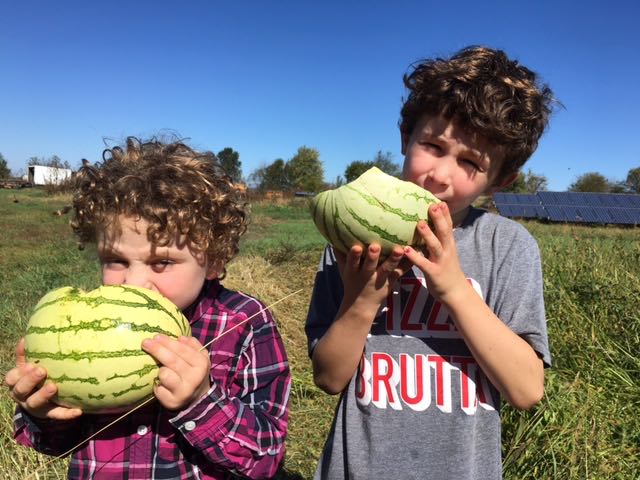
There were late-maturing melons to test how well you judge watermelon ripeness. Photo credit Shelly D
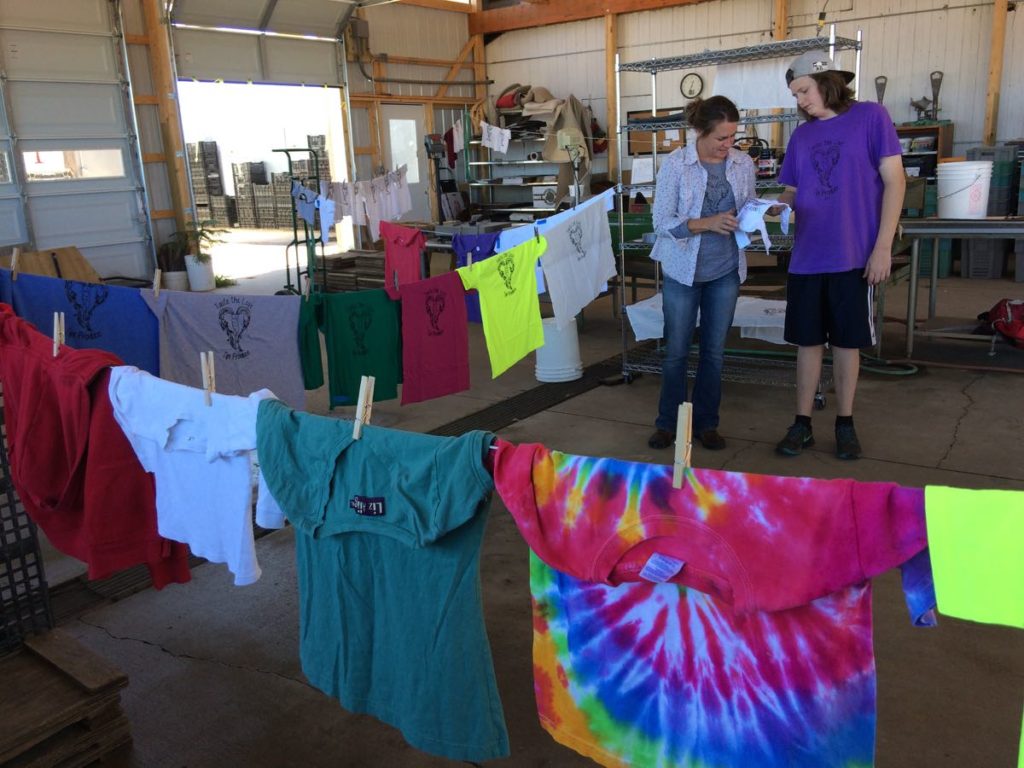
Karen and Chance silk-screened a gazillion t-shirts.

Freshly printed t-shirts in immediate use.
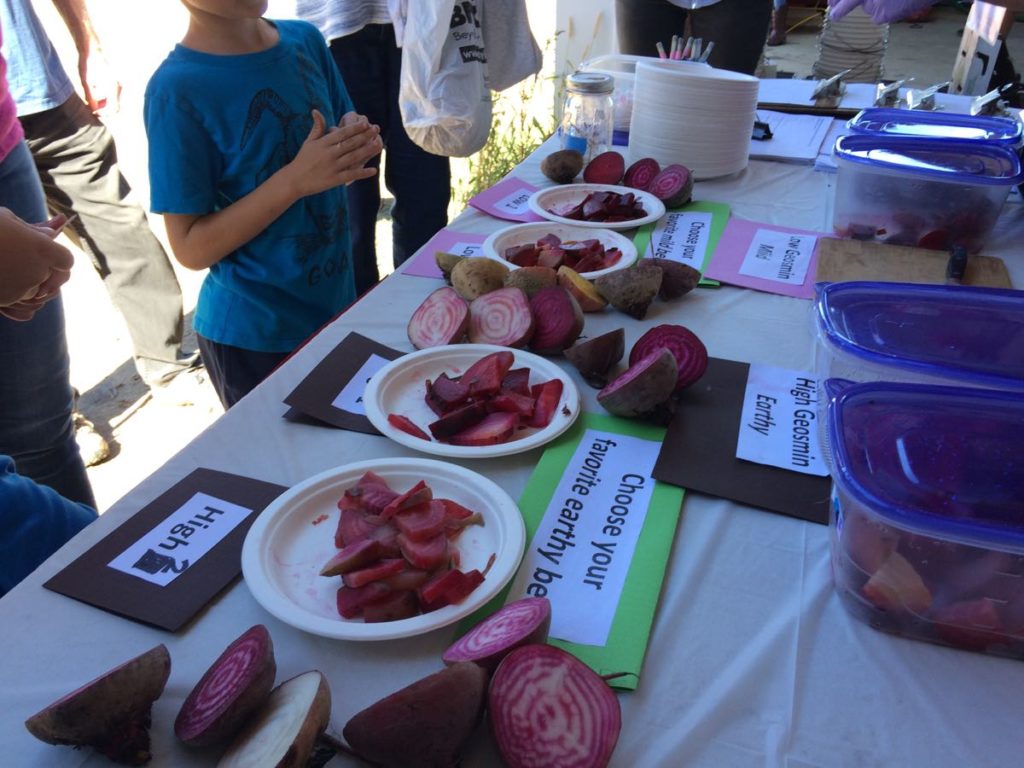
UW grad student Solveig Hanson (at right) is breeding beets for different flavor components. She offered beets for tasting, and collected members’ opinions about the flavor and appearance of her breeding lines. I explained to Solveig that you folks are not a typical population. You are a self-selected group of vegetable enthusiasts. We have helped raise Solveig’s beets for the last two years. She values having her selections grown within a genuine farm setting. After last season, Solveig decided to enroll in our CSA, giving us 100% participation of UW beet-breeding grad students. Solveig asked me to thank all of you who participated in the tasting and survey at the upick.
Veggie List and Veggie Notes (Oct. 5/6, 2017, week #22, green EOW)
Winter squash, 1 or 2
Parsnips, 1.5 lb
Carrots, 2 lb
(together in one bag)
Red bor kale, 1 bunch
Purple cauliflower
Bell peppers, ~2
Romano beans, 0.9 lb
Kohlrabi
Yellow onions
Scallions, 1 bunch
Garlic
Next week’s box will probably contain winter squash, potatoes, Brussels sprouts, leeks, carrots, scallions and more.
Parsnips (tapered, cream colored roots) – Those long, white roots are not carrots, they are parsnips. The two vegetables are related. When cooked, parsnips are sweet and starchy. For the best flavor, brown them to caramelize the sugars. Here are a few ideas for parsnip preparation:
– Caramelize the parsnips by roasting them in a vegetable medley.
– Parsnip fries are delicious: cut like French fries, oil lightly, place on a cookie sheet and roast in a hot oven until brown and cooked through.
– Try substituting grated parsnips in a potato pancake recipe. They brown beautifully and are very tasty.
– Steve loves pan-fried parsnips with onions and garlic.
Romano beans – These big beans need braising or long-cooking. They are worth the effort – lots of flavor. These are the last beans of the season. Steve is having trouble letting them go.
Winter squash – Everyone gets one or two squash, depending on size. This week’s squash are Festival (speckled acorn), Carnival (speckled acorn) or Sugar Dumpling (like a very solid sweet dumpling). Some squash have dry flaws that need trimming. I encourage you to eat these squash soon. These varieties are valuable because they are full-flavored and ready to eat soon after harvest, unlike butternuts which need time to cure. The flip side is that they do not store for long.
Purple cauliflower – Like regular cauliflower but prettier. When cooked, the color darkens but persists.
RECIPE LOG
Visit our Recipe Log, a list of all our 2017 recipes. Pat has given us a number of recipes for kale or other greens. Check out July 27, August 24, Sept. 28.
LOCAL THYME RECIPES
Comforting Classics
Lemony Cauliflower Pasta
Irish Root Vegetable and Bean Stew
Egg Salad Sandwiches with Carrot, Kohlrabi and Onion
Microwave Maple Soy Glazed Winter Squash
Outside the Box Recipes
Curry Roasted Cauliflower and Root Vegetables
Parsnip Cake with Cream Cheese Frosting
Kohlrabi Apple Salad
Squash and Caramelized Onion Pizza
Quick and Easy Meal
Kale and Pepper Eggs Benedict
RECIPES FROM LAUREN
ROASTED CAULIFLOWER & PARSNIP SOUP
There are so many fall things in this box, they just go together like a dream with minimal work. Part of me just wants to tell you to serve a huge dish of roasted cauliflower, parsnips, winter squash, onions and garlic seasoned with maple syrup and thyme with every meal you serve this week (which you can absolutely also do), but the other part of me loves to pair these same exact flavors with coconut milk and puree it into the most velvety, beautiful soup. If you have purple cauliflower, this soup will be pale purple which only makes me love it all the more. Lauren
Takes 1 hour, 15 minutes
Serves 6-8
1-1/2 pounds parsnips, peeled and cut into chunks
1 head cauliflower, cut into florets
2 garlic cloves, sliced
1/4 cup olive oil
2 teaspoons salt, divided
3/4 teaspoon freshly ground black pepper, divided
2 tablespoon butter
1/2 yellow onion, peeled and diced
1 large winter squash, peeled, seeded and diced
2 tablespoons maple syrup
1 teaspoon dried thyme
1/4 teaspoon red pepper flakes
9 cups water
15-ounce can full-fat coconut milk
- Preheat oven to 425 degrees.
- Combine parsnips, cauliflower and garlic with olive oil, 1 teaspoon salt and 1/2 teaspoon pepper on two large baking sheets. There’s a chance it would all fit on one sheet, but the veggies will just steam instead of getting all that delicious carmelization that comes from roasting. It’s worth the one extra pan to wash. I promise. Roast for 40 minutes, tossing veggies halfway through.
- In a large stock pot, melt butter. Add onion plus remaining salt and pepper. Saute for 5 minutes until onions are softened and fragrant. Add roasted veggies, diced squash, maple syrup, time and red pepper flakes. Stir and saute for a couple minutes to allow flavors to combine.
- Add water and coconut milk. Bring to a boil, reduce to a simmer and cook for 25 minutes until the squash is tender.
- Puree with an immersion blender (or blender or in your food processor in batches) until smooth. Taste and adjust seasonings as desired.
- Serve warm on a cold day.
.
ROMANO BEAN & CARROT FRIED RICE
I have fallen in love with fried rice this summer. It is the perfect vehicle for almost any summer veggies and quick to whip up with a bit of advanced planning. I love to make a huge batch of rice on Sundays and store it in my fridge until a weeknight where I’m not feeling creative. Cooking the rice ahead saves on time and also helps with the texture of the fried rice, allowing it to crisp up a bit more (if that sort of thing matters to you).
Also note that step 3 is completely optional. If you don’t care about crispy rice, you can just toss the already cooked rice (warmed in the microwave) with the veggies along with the salt and sesame oil it would have been cooked with. Lauren
Takes 1 hour
Serves 6-8
3 tablespoons butter, divided
.9 pound romano beans, thinly sliced
1 teaspoon Kosher salt, divided
2 garlic cloves, minced
1-2 tablespoons soy sauce, divided
1/2 cup water
2 carrots, diced
1 colored pepper, diced
1 tablespoon + 1 teaspoon oyster sauce, divided
6 cups cooked white rice
3 tablespoons toasted sesame oil
1 bunch scallions (white and pale green parts only, reserve dark green tops for another use), sliced
6-8 eggs
Sriracha, for serving
- Melt 2 tablespoons butter in a large saute pan over medium heat. (If you don’t have a 7+ quart saute pan, it won’t be big enough and use a stock pot or Dutch oven instead). Add romano beans along with 1/2 teaspoon of salt. Saute for 10 minutes until very tender. Add garlic, 1 teaspoon soy sauce and water to pan. Let simmer for 15 minutes until the liquid has evaporated. While that simmers, dice your carrots and bell peppers.
- Add carrots, peppers and 1 tablespoon each soy sauce and oyster sauce. Cook over medium high heat until carrots are tender and no liquid remains, 5-10 minutes. Remove cooked veggies to a very large bowl.
- Optional step (see note above). In the same pan you used to cook the veggies, pour 2 tablespoons of sesame oil in so it coats the bottom. (If there was residue from the veggies, just whip it out with a towel quickly). Heat the oil over medium high heat until hot but not smoking. Dump in your fried rice and sprinkle with remaining 1/2 teaspoon salt. Cook on medium high heat for 6-10 minutes, stirring and scraping often so that the rice gets crispy in places but doesn’t burn to the bottom of the pan. Add 1 additional tablespoon sesame oil and 1 tablespoon of butter as you go to keep things from sticking.
- Add rice to bowl of veggies followed by sliced scallions and 1 teaspoon oyster sauce. Stir to combine well and then taste. Add 1-2 teaspoons soy sauce based on your tastes.
- Serve warm with a fried egg and hot sauce. You can also scramble your eggs and fold them into the fried rice if you prefer.
.
Week #21, Oct 5 2017
- On: October 04, 2017
 0
0
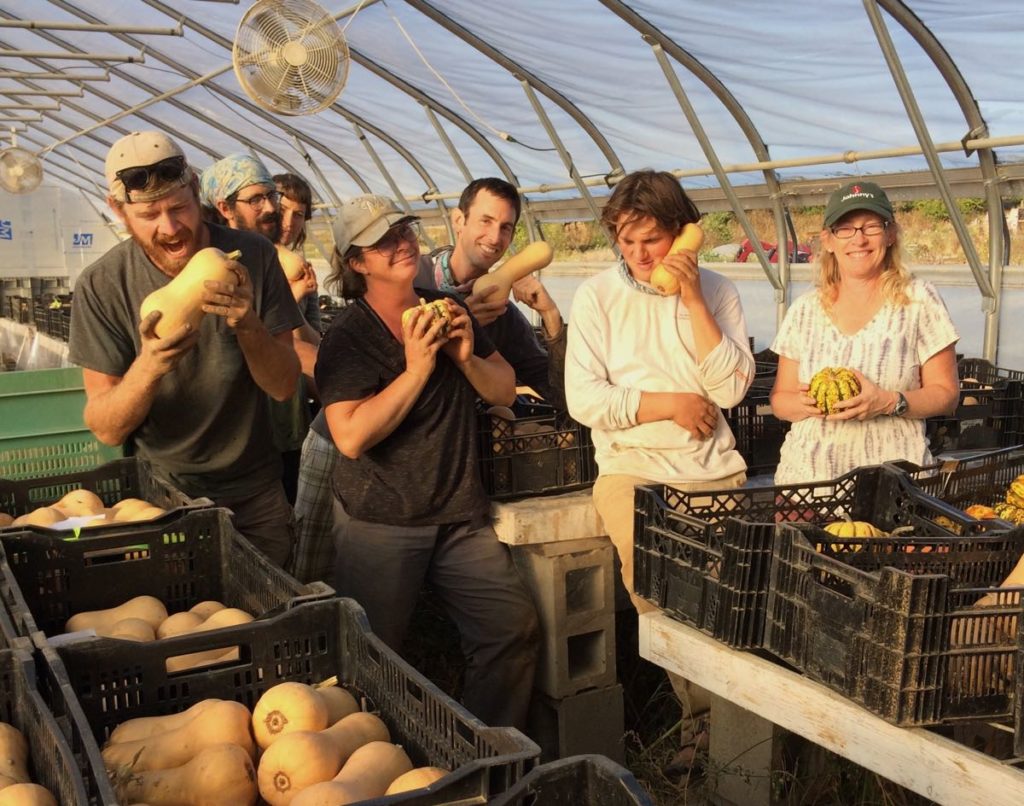
From left, Billy (ready for a snack), Smitty, Charlotte, Kristin (with a favorite squash), Jon, Jory (taking a call during our photo shoot!) and me (playing straight man). MIA Karen, Maggie & Simone.
Our winter squash crew gets a big thank you from me. Together, we clipped and picked up many, many squash over the last few weeks. It’s an exacting job to judge ripeness of the different varieties. Also, we notice that squash get heavier after you pick up a few hundred. Special thanks to Kristin, who stuck with me through every harvest this year, and to Jon and Karen who have helped with squash harvests for many years. Each crop needs judgement which makes it so valuable to work with the same crew each year. This year’s harvests happened during dry weather, perfect for us and perfect for the squash. Beth
Sweet potato harvest
Our main sweet potato harvest happened this week. (The sweet potatoes in this week’s box are from a smaller harvest a few weeks ago.) This week’s harvest was perfect. You can’t dig the sweets out of dry ground – they damage too easily. Steve irrigated the field a few days ago so the ground would be moist. Last night’s rain helped. Soil moisture was perfect and the sweet potatoes popped right out of the ground. So satisfying.
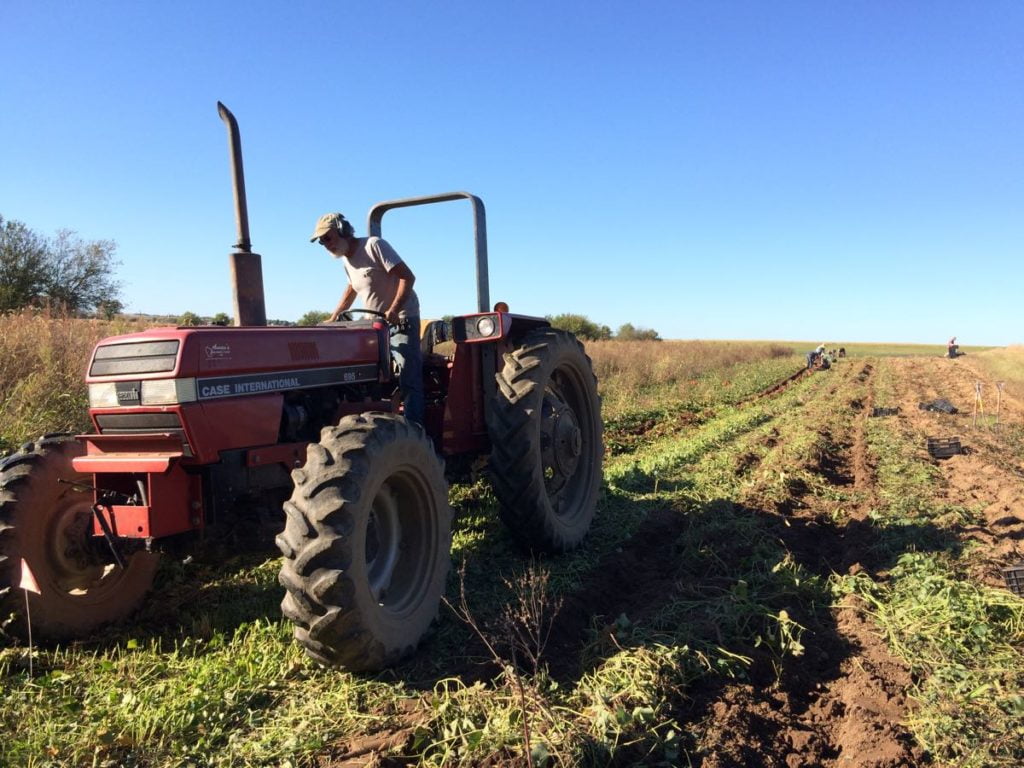
Steve undercuts the roots with the tractor and digger.
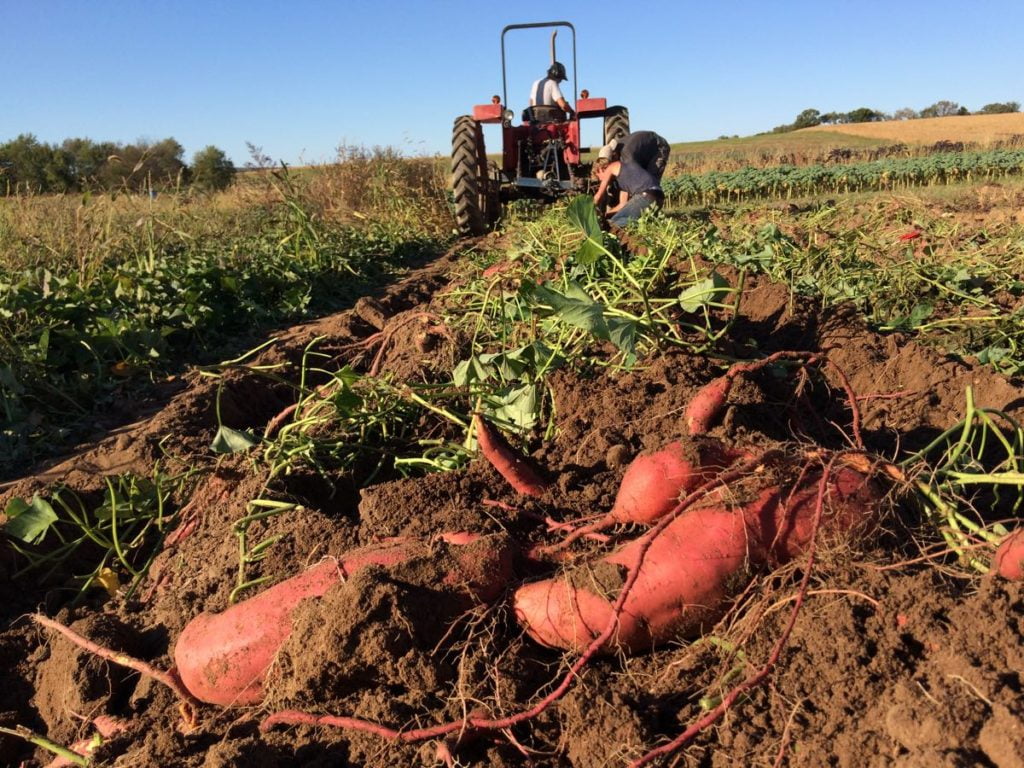
If conditions are good, the sweet potatoes end up on the surface.
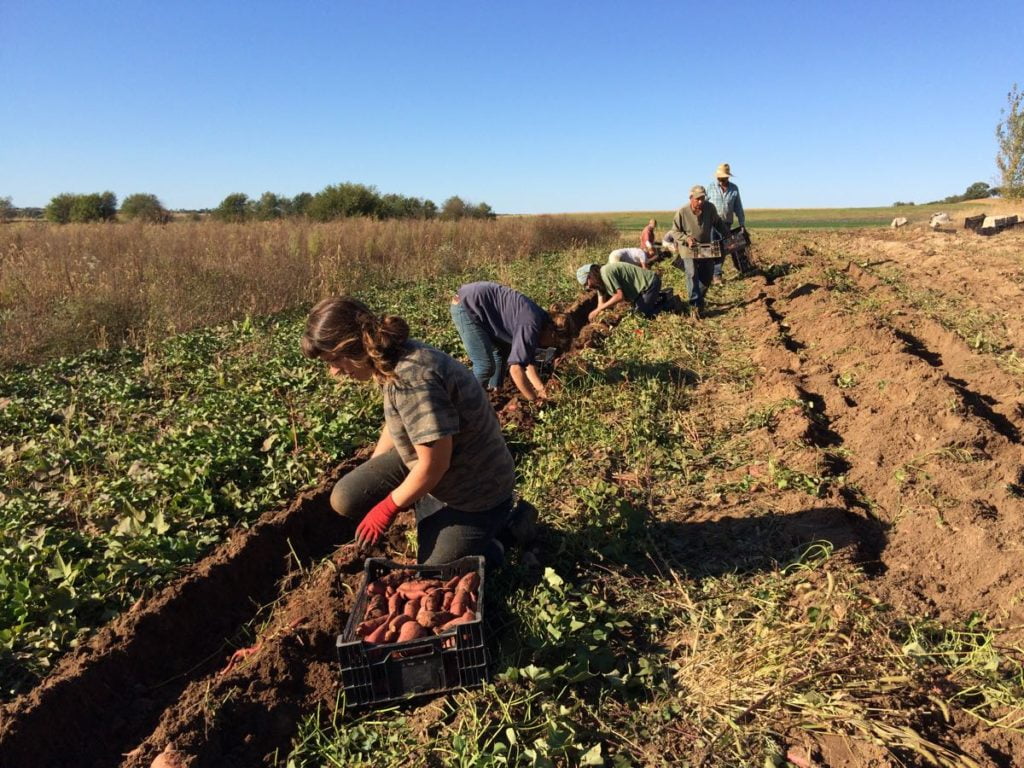
We pick them up by hand. It helps to gather a mob for this step. This crop is also heavy.
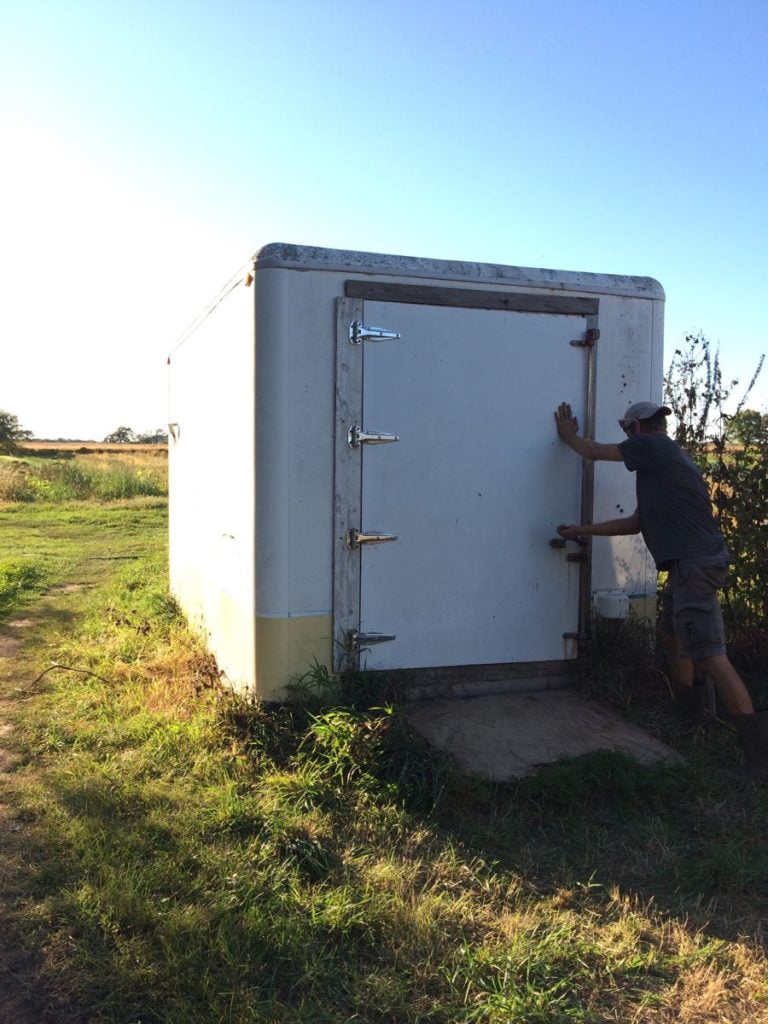
We put them in an insulated truck box and crank up the heat to 86 degrees with high humidity for a few days. That starts the curing process so the tubers sweeten and the skins toughen. Curing helps heal any dings and scrapes that happen during harvest.
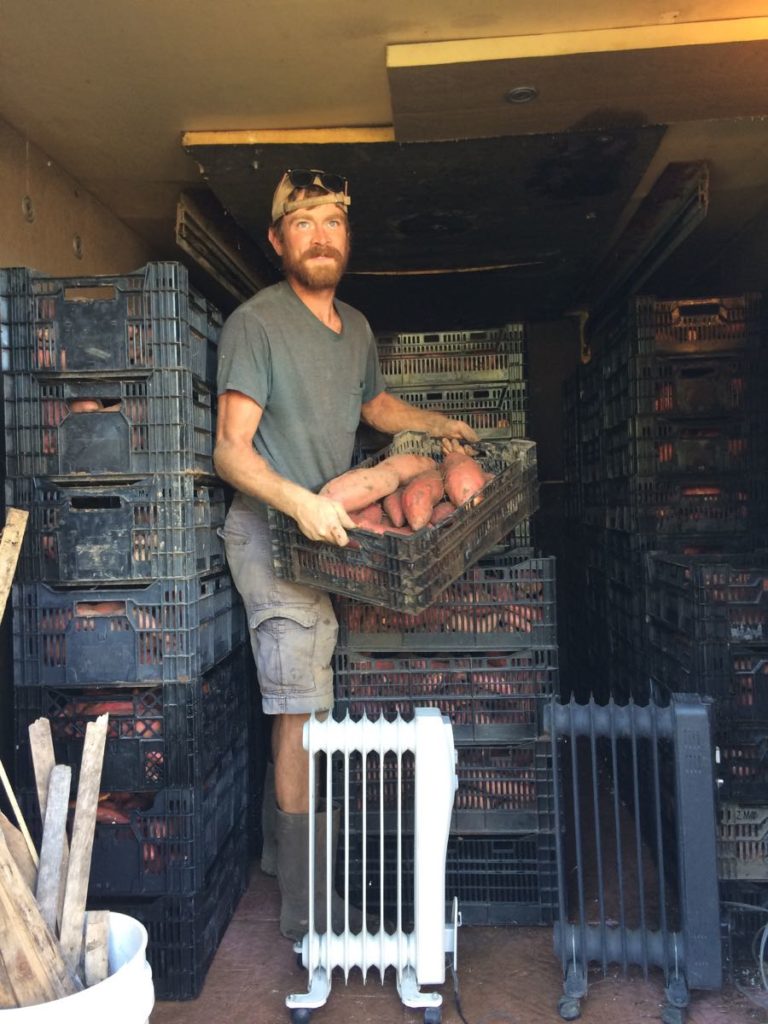
Billy (above), Kerry and Jory stacked the sweet potatoes in rows for good air movement.
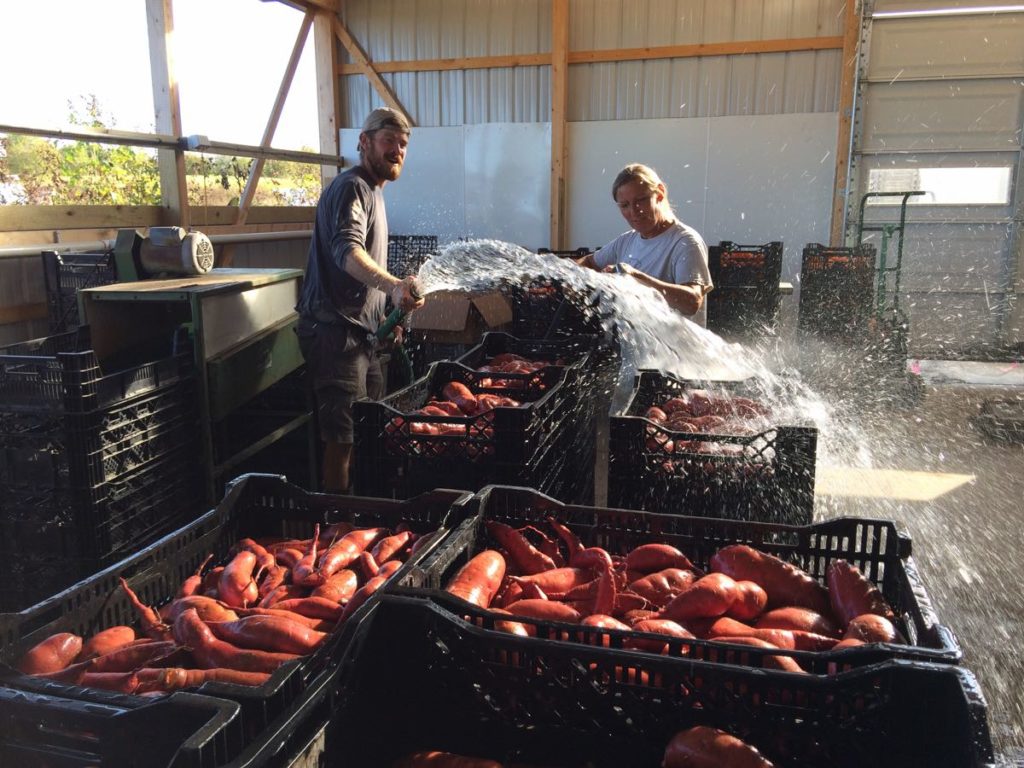
Wetting down this week’s sweet potatoes before washing. We dug these ones about three weeks ago.
Veggie List and Veggie Notes
October 5/6, 2o17; week #21, purple EOW, sun SMP
Green cabbage
Sweet potatoes, ~2 lb
Romano beans, 1.9 lb
Edamame soybeans, 1 bundle
Red mizuna, 1 bunch
Winter squash, 1 or 2
Red onion
Slicing tomatoes, a few
Bell peppers, 2
Some sites get broccoli.
Some sites get cauliflower.
Next week’s box will probably contain winter squash, broccoli or cauliflower, kale or collards, peppers, carrots, scallions and more.
‘Beauregard’ sweet potatoes – Here are a few things we’ve learned about sweet potatoes:
– For best flavor, cook your sweet potatoes so they brown and caramelize. We have a simple, favorite way to roast sweet potatoes. We used to prepare sweet potato fries in the oven. Now we just quarter the potatoes, rub with olive oil, dust with salt and place cut-side-down on a cookie sheet. Roast in a 450 F oven without turning until soft. The flavors will caramelize (like sweet potato fries) but preparation is simpler and the cooking time less exacting. Slender sweet potato fries go from undercooked to overcooked in the blink of an eye. Larger slices are less exacting, and therefore are easier. Small sweet potatoes can be cut just in half. Jumbos will need to be chopped into pieces. Otherwise, they will take a long time to cook.
– Store your sweet potatoes at room temperature. They suffer chilling injury below 50 F.
– The sweet potatoes we grow require slightly longer cooking than ones from the supermarket, perhaps because they contain higher moisture so soon after harvest.
– Sweet potatoes are good at any size. We have cooked everything from tiny to jumbo and consistently find that all sizes taste good.
Romano beans – Steve says these are ‘meaty’ this week. They aren’t overripe. They are just big, perfect for braising recipes.
Edamame soybeans (bundle of green stems with pods attached) – These edible soybeans are a treat. Pull the pods from the stem and wash well. It helps to submerge the pods and rub them together. Boil in water until the pods have split and the beans are quite tender. Season with salt and pop the beans out of the pods into your mouth. This Japanese specialty is becoming more and more popular in the USA.
Storage: Remove the pods from the stems promptly and refrigerate.
Mizuna – Mizuna is similar to mustard greens but with the pepperiness of arugula. Good raw in salads or cooked in any recipe that calls for mustard greens. Cooking tames the pepperiness. Use the leaves and younger, more tender stems. Discard older stems as they can be tough.
Slicing tomatoes – I fibbed last week. These are the final tomatoes of the season. They aren’t as flavorful as summer tomatoes but are surprisingly good for this time of year. Thank the dry weather. You should refrigerate these tomatoes because they are not going to store well at room temperature. Eat soon.
Winter squash – You’ll get one of the types in the photo. They are ready to eat, and should be eaten within two weeks. Store your squash at room temperature on your kitchen counter where you can keep an eye on it.
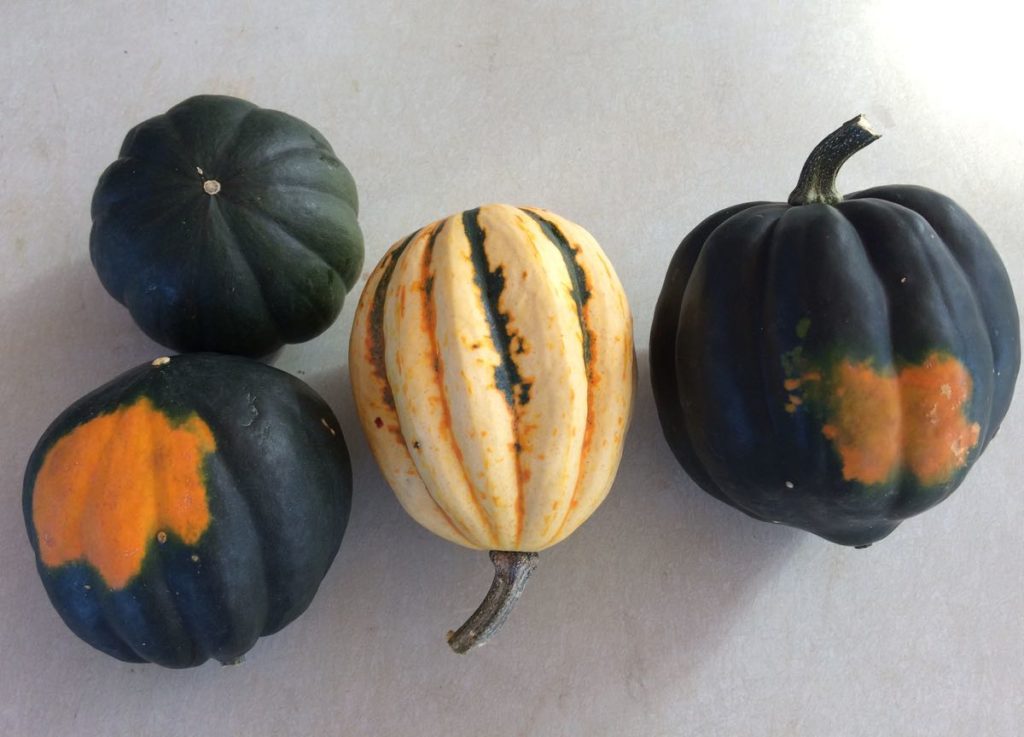
This week’s winter squash. Each site gets one type. From left, Sugar Bush acorn, Jester, TipTop acorn.
RECIPE LOG
Visit our Recipe Log, a list of all our 2017 recipes. Pat and Lauren have given us lots of broccoli and bean recipes already this year. Check out 9/21/17 for a few winter squash recipes.
LOCAL THYME RECIPES
Comforting Classics
Braised Mustard Greens
Minestrone with Peppers, Tomatoes, Cabbage and Romano Beans
Risotto with Braised Green Cabbage
Sweet Potato Puree
Outside the Box Recipes
Mizuna & Turkey Salad
Braised Romano Bean with Feta and Lemon Pepper
Slow Roasted Cabbage Chips
Chipotle Chicken and Sweet Potato Burrito
Quick and Easy Meal
Sweet Potato Posole with Black Beans

